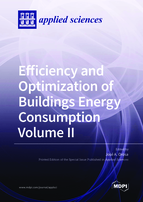Efficiency and Optimization of Buildings Energy Consumption: Volume II
A special issue of Applied Sciences (ISSN 2076-3417). This special issue belongs to the section "Energy Science and Technology".
Deadline for manuscript submissions: closed (20 March 2021) | Viewed by 29048
Special Issue Editor
Interests: marine engineering; energy; thermodynamics; naval architecture; sustainability
Special Issues, Collections and Topics in MDPI journals
Special Issue Information
Dear colleagues,
In 2007, the European commission began a process to define targets to be implemented in the near future and in a long-term period. The objective was to slow down climate change and energy consumption or to reduce the greenhouse gas emissions (GHG) by decreasing the use of fossil fuels, increasing renewables, and improving the efficiency of the systems that employ fossil fuels when they cannot be replaced. In particular, it must be highlighted that 45% of the EU’s GHG are from large-scale facilities in the power and industrial sectors, as well as the aviation sector, and that 55% of the EU’s GHG are from the remaining sectors such as housing, agriculture, waste, and transport (excluding aviation). The first period has recently finished (from 2007 to 2020) and was based on three key targets:
- 20% cut in greenhouse gas emissions (from 1990 levels);
- 20% of EU energy from renewables;
- 20% improvement in energy efficiency.
While most of these targets have not yet been reached at this stage, a clear tendency to reduce GHG can be observed. In consequence, new percentages of these same targets were fixed for the year 2030. It is common sense that short-term targets are not the best solution and only long-term planning will let us improve the actual situation. In consequence, a long-term strategy for 2050 was defined by the EU with the objective to be an economy with net-zero greenhouse gas emissions and take new steps looking for traditional and new ideas to be translated into proposals for all Parties to the Paris Agreement.
As commented before and shown in our previous Special Issue on “Efficiency and Optimization of Buildings Energy Consumption”, housing is one of the biggest energy consumption sectors, and renewable energies and energy efficiency are considered complementary activities to reduce the total energy consumption from fossil fuels. This new Special Issue aims to help EU Member States to develop their national long-term strategies by sharing original ideas and real case studies to reduce their energy consumption in buildings centered on contemporary, new technologies.
Prof. Dr. José A. OrosaGuest Editor
Manuscript Submission Information
Manuscripts should be submitted online at www.mdpi.com by registering and logging in to this website. Once you are registered, click here to go to the submission form. Manuscripts can be submitted until the deadline. All submissions that pass pre-check are peer-reviewed. Accepted papers will be published continuously in the journal (as soon as accepted) and will be listed together on the special issue website. Research articles, review articles as well as short communications are invited. For planned papers, a title and short abstract (about 100 words) can be sent to the Editorial Office for announcement on this website.
Submitted manuscripts should not have been published previously, nor be under consideration for publication elsewhere (except conference proceedings papers). All manuscripts are thoroughly refereed through a single-blind peer-review process. A guide for authors and other relevant information for submission of manuscripts is available on the Instructions for Authors page. Applied Sciences is an international peer-reviewed open access semimonthly journal published by MDPI.
Please visit the Instructions for Authors page before submitting a manuscript. The Article Processing Charge (APC) for publication in this open access journal is 2400 CHF (Swiss Francs). Submitted papers should be well formatted and use good English. Authors may use MDPI's English editing service prior to publication or during author revisions.
Keywords
- Building construction
- Energy saving
- New energy technologies
- Optimization
- Building design
- Energy consumption
- Zero-energy buildings
- Sustainable buildings






